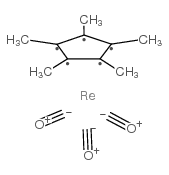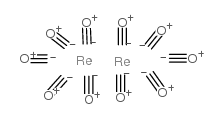12130-88-0
| Name | Pentamethylcyclopentadienylrhenium tricarbonyl |
|---|---|
| Synonyms |
Pentamethylcyclopentadienylrhenium tricarbonyl,min.
pentamethylcyclopentadienyltricarbonylrhenium PENTAMETHYLCYCLOPENTADIENYLRHENIUM TRICARBONYL |
| Melting Point | 149-151ºC |
|---|---|
| Molecular Formula | C13H15O3Re |
| Molecular Weight | 405.46300 |
| Exact Mass | 406.05800 |
| LogP | 2.34800 |
|
Section 1: Product Identification Chemical Name:Pentamethylcyclopentadienylrhenium tricarbonyl, min. 98% CAS Registry Number:12130-88-0 Formula:[(CH3)5C5]Re(CO)3 EINECS Number:none Chemical Family:metal carbonyl complexes Synonym:Permethylcyclopentadienylrhenium tricarbonyl
Section 2: Composition and Information on Ingredients IngredientCAS NumberPercentACGIH (TWA)OSHA (PEL) Title Compound12130-88-0100%no datano data Section 3: Hazards Identification Emergency Overview:Irritating to skin, eyes and respiratory tract. Primary Routes of Exposure:Ingestion, inhalation, skin, eyes Eye Contact:Causes slight or mild irritation of the eyes. Skin Contact:Causes slight to mild irritation of the skin. Inhalation:Irritating to the nose, mucous membranes and respiratory tract. Ingestion:No information is available on the physiological effects of ingestion Acute Health Affects:Irritating to skin, eyes and respiratory tract. Chronic Health Affects:No information available on long-term chronic effects. NTP:No IARC:No OSHA:No SECTION 4: First Aid Measures Immediately flush the eyes with copious amounts of water for at least 10-15 minutes. A victim may need Eye Exposure: assistance in keeping their eye lids open. Get immediate medical attention. Wash the affected area with water. Remove contaminated clothes if necessary. Seek medical assistance if Skin Exposure: irritation persists. Remove the victim to fresh air. Closely monitor the victim for signs of respiratory problems, such as difficulty in Inhalation: breathing, coughing, wheezing or pain. In such cases seek immediate medical assistance. Seek medical attention immediately. Keep the victim calm. Give the victim water (only if conscious). Induce Ingestion: vomiting only if directed by medical personnel. SECTION 5: Fire Fighting Measures Flash Point:no data Autoignition Temperature:no data Explosion Limits:no data Extinguishing Medium:carbon dioxide, dry chemical or foam If this product is involved in a fire, firefighters should be equipped with NIOSH approved positive pressure Special Fire Fighting Procedures: self-contained breathing apparatus and full protective clothing. Hazardous Combustion andIf involved in a fire this material may emit irritating rhenium oxide fumes. Decomposion Products: Unusual Fire or Explosion Hazards: No unusual fire or explosion hazards. SECTION 6: Accidental Release Measures Spill and Leak Procedures:Small spills can be mixed with sodium carbonate or vermiculite and swept up. SECTION 7: Handling and Storage Handling and Storage:Store in a cool, dry well-ventilated area away from heat and direct sunlight. Keep containers tightly sealed. SECTION 8: Exposure Controls and Personal Protection Eye Protection:Always wear approved safety glasses when handling a chemical substance in the laboratory. Skin Protection:Wear protective clothing and gloves. Ventilation:This product should be handled in an efficient fume hood. If ventilation is not available a respirator should be worn. The use of respirators requires a Respiratory Respirator: Protection Program to be in compliance with 29 CFR 1910.134. Ventilation:This product should be handled in an efficient fume hood. Additional Protection:No additional protection required. SECTION 9: Physical and Chemical Properties Color and Form:off-white powder Molecular Weight:405.46 Melting Point:149-151° Boiling Point:no data Vapor Pressure:no data Specific Gravity:no data Odor:none Solubility in Water:insoluble SECTION 10: Stability and Reactivity Stability:air and moisture stable Hazardous Polymerization:no hazardous polymerization. Conditions to Avoid:none Incompatibility:oxidizing agents, halogens and active metals. Decomposition Products:carbon dioxide, carbon monoxide, organic fumes and rhenium oxide SECTION 11: Toxicological Information RTECS Data:No information available in RTECS. Carcinogenic Effects:no data Mutagenic Effects:no data Tetratogenic Effects:no data SECTION 12: Ecological Information Ecological Information:No information available. SECTION 13: Disposal Considerations Disposal:Dispose of according to local, state and federal regulations. SECTION 14: Transportation Shipping Name (CFR):Non-hazardous Hazard Class (CFR):NA Additional Hazard Class (CFR):NA Packaging Group (CFR):NA UN ID Number (CFR):NA Shipping Name (IATA):Non-hazardous Hazard Class (IATA):NA Additional Hazard Class (IATA):NA Packaging Group (IATA):NA UN ID Number (IATA):NA SECTION 15: Regulatory Information TSCA:Not listed in the TSCA inventory. SARA (Title 313):Title compound not listed. Second Ingredient:none SECTION 16 - ADDITIONAL INFORMATION N/A |
| Safety Phrases | 24/25 |
|---|
| Precursor 5 | |
|---|---|
| DownStream 0 | |




![[Cp*Re(III)(CO)2Br(CO2CH2-C6H4F)] structure](https://image.chemsrc.com/caspic/453/1185747-92-5.png)
